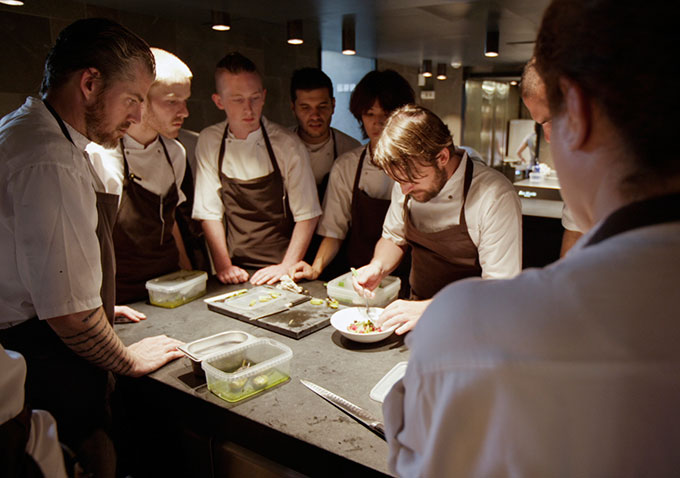 When making a documentary about food, how do you express the two most central senses to the experience that film fails to capture: taste and scent? Without Smell-O-Vision or another gimmicky technology, you’re left largely with the visual, and first-time feature director Pierre Deschamps relies heavily on beautiful cinematography for “Noma: My Perfect Storm.” Though having el Bulli’s Ferran Adriå appear to compliment your subject’s food doesn’t hurt either. The documentary centers on chef René Redzepi and his acclaimed Copenhagen restaurant Noma, which has jockeyed for the title of top restaurant in the world over the last few years.
When making a documentary about food, how do you express the two most central senses to the experience that film fails to capture: taste and scent? Without Smell-O-Vision or another gimmicky technology, you’re left largely with the visual, and first-time feature director Pierre Deschamps relies heavily on beautiful cinematography for “Noma: My Perfect Storm.” Though having el Bulli’s Ferran Adriå appear to compliment your subject’s food doesn’t hurt either. The documentary centers on chef René Redzepi and his acclaimed Copenhagen restaurant Noma, which has jockeyed for the title of top restaurant in the world over the last few years.
Deschamps and his camera capture the vivid color and texture of each dish at Noma, showcasing bright greens and deep purples. Each image is crisp. Close-ups and slow motion expose the care paid to each detail of every plate, while fast motion expresses the frenetic energy of the kitchen during service. There are shots of steam rising off a pair of eggs in a nest presented for the diner, and the camera explores the forests where the chefs forage, showing the true origins of the food.
 Provenance is key for Noma: the restaurant subscribes to — and helped found — the concept of New Nordic cuisine. There’s a focus on what’s available in the region at a particular time, emphasizing seasonality above all with an eagerness for foraging that might seem surprising even to other farm-to-table devotees. Dishes featured in the film include at bread and grilled roses; crispy reindeer moss, spice and creme fraiche; and wild blueberry and ants
Provenance is key for Noma: the restaurant subscribes to — and helped found — the concept of New Nordic cuisine. There’s a focus on what’s available in the region at a particular time, emphasizing seasonality above all with an eagerness for foraging that might seem surprising even to other farm-to-table devotees. Dishes featured in the film include at bread and grilled roses; crispy reindeer moss, spice and creme fraiche; and wild blueberry and ants
Scandinavia wasn’t internationally known for its food prior to Redzipi and his co-founder Claus Meyer, but Noma has elevated Copenhagen into a foodie destination as the restaurant itself has been voted best in the world multiple times. Similar to Danish cinema’s Dogme 95, Danish cuisine is authoritarian, though Redzipi’s approach is less strictly adherent than Lars von Trier and Thomas Vinterberg were in the cinematic movement’s early years.
 “Noma: My Perfect Storm” spends a few years with Redzipi and the restaurant, getting intimate access to the chef, his family and his kitchen. The film shares not only the restaurant’s successes but also its failures. A norovirus outbreak challenged not only Noma’s bottom line and its perception, but also its entire ethos of foraging and seasonality. The documentary also captures the moment when Noma no longer holds the title of the best restaurant in the world. All that stress wears on Redzipi and his staff, as they try to reclaim their status.
“Noma: My Perfect Storm” spends a few years with Redzipi and the restaurant, getting intimate access to the chef, his family and his kitchen. The film shares not only the restaurant’s successes but also its failures. A norovirus outbreak challenged not only Noma’s bottom line and its perception, but also its entire ethos of foraging and seasonality. The documentary also captures the moment when Noma no longer holds the title of the best restaurant in the world. All that stress wears on Redzipi and his staff, as they try to reclaim their status.
Failure is seen as a key component to the restaurant’s acclaim, with risk-taking seen as paramount. Noma’s staff is encouraged to create bold dishes for each other for their in-house Saturday night project dinners. Likewise, Redzipi’s controversial approach to service (“Fuck the bow ties,” he says when given advice to have his servers dress more formally) challenges the conventions of what is seen as a top-tier restaurant.
 “Noma: My Perfect Storm” is crafted with exquisite care in the vein of its subject, though it occasionally feels overly precious (criticism that might be leveled at the restaurant itself by its detractors). There’s little doubt that this type of cooking requires an artistry that should place it on the same level with other creative achievements. Throughout the film, comparisons to artists, musicians, and athletes at the top of their game are made, and “Noma: My Perfect Storm” makes a powerful argument for Redzipi’s inclusion with these masters. Fans of “Jiro Dreams of Sushi,” “Chef’s Table” and other works that elevate chef to artist should find much to enjoy here. [B+]
“Noma: My Perfect Storm” is crafted with exquisite care in the vein of its subject, though it occasionally feels overly precious (criticism that might be leveled at the restaurant itself by its detractors). There’s little doubt that this type of cooking requires an artistry that should place it on the same level with other creative achievements. Throughout the film, comparisons to artists, musicians, and athletes at the top of their game are made, and “Noma: My Perfect Storm” makes a powerful argument for Redzipi’s inclusion with these masters. Fans of “Jiro Dreams of Sushi,” “Chef’s Table” and other works that elevate chef to artist should find much to enjoy here. [B+]

